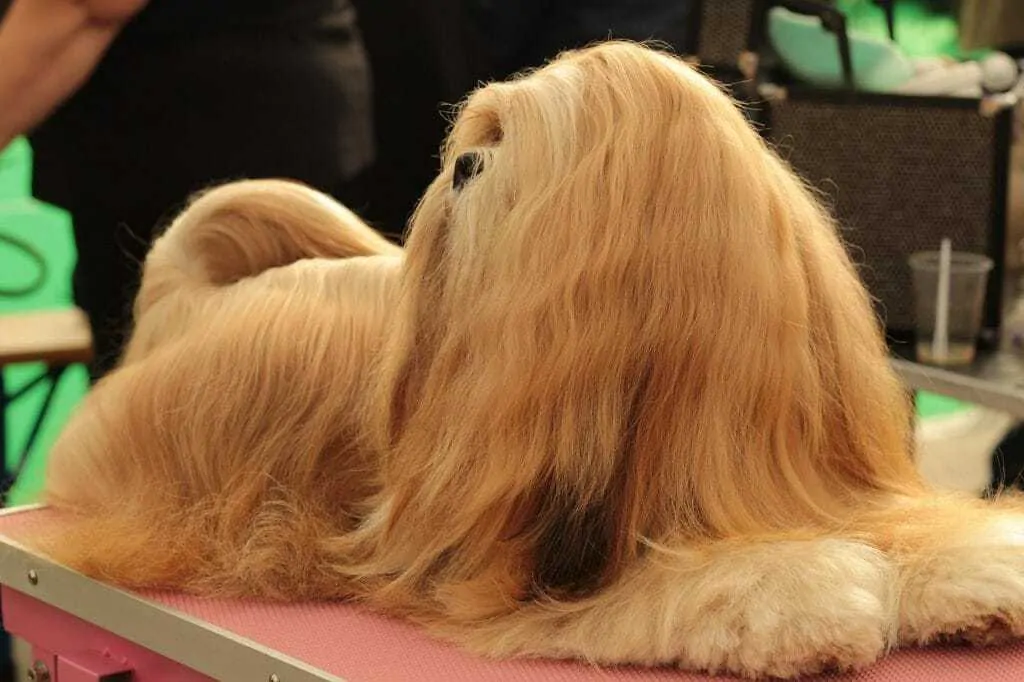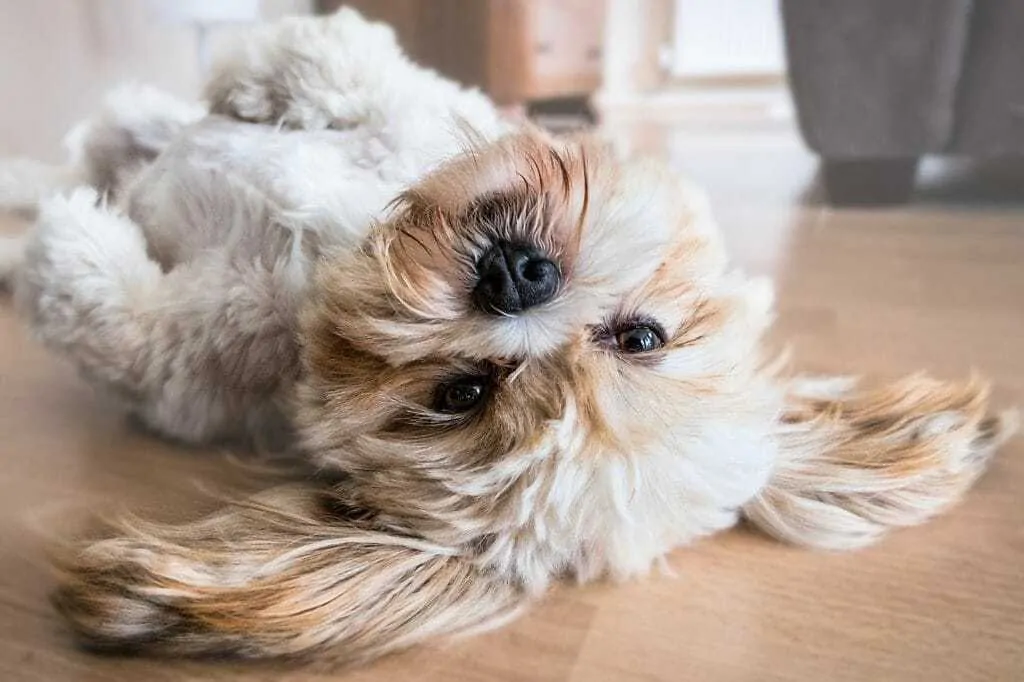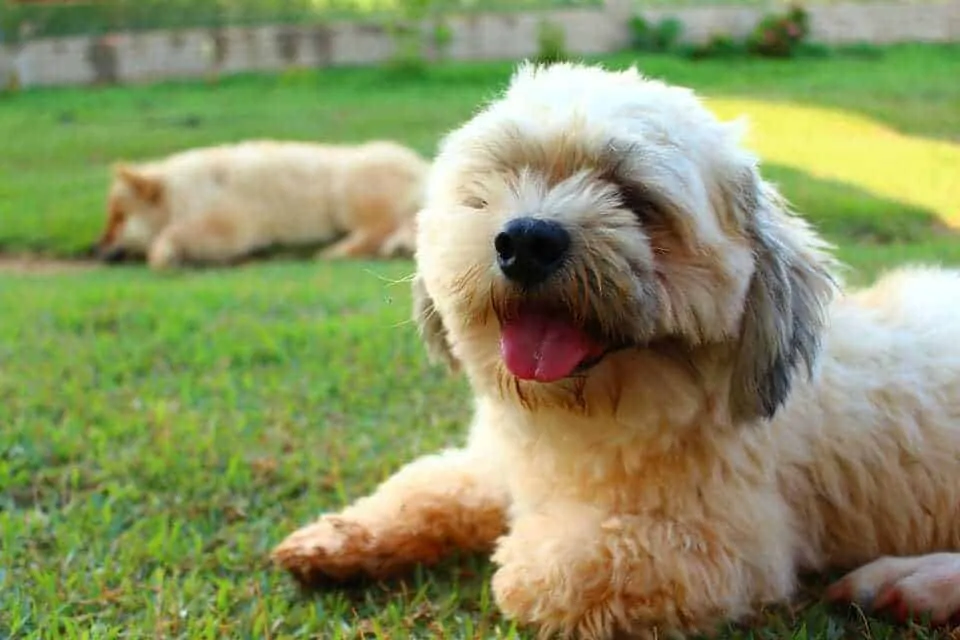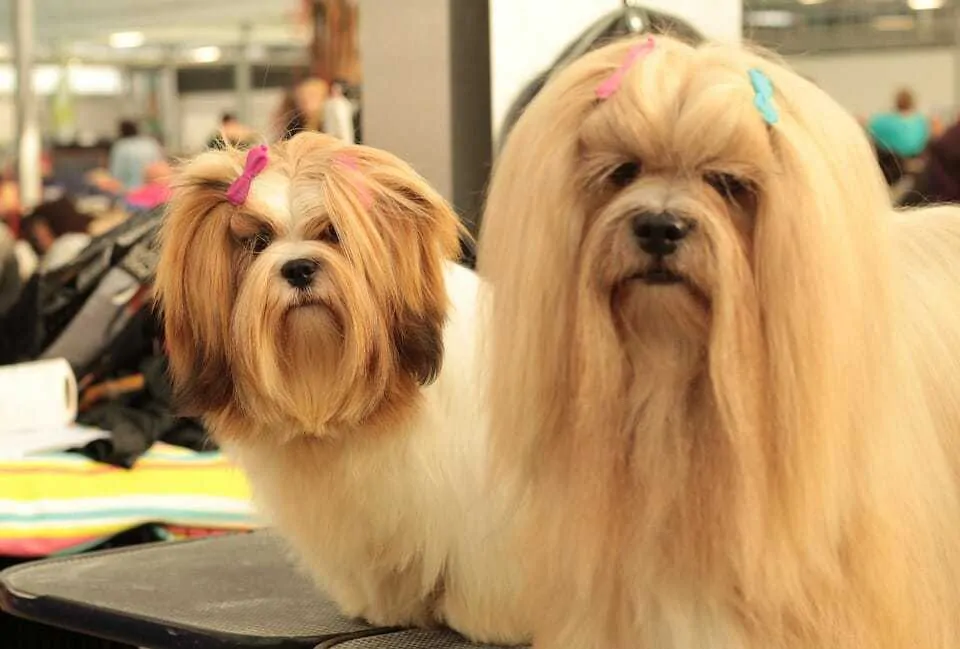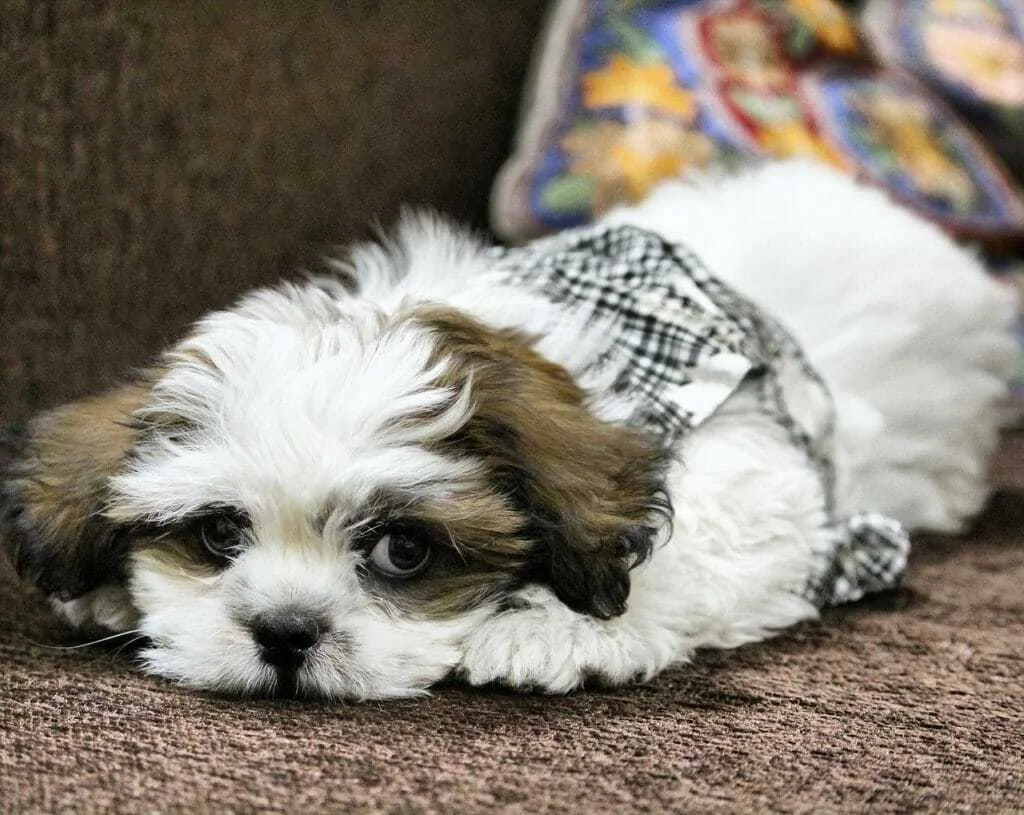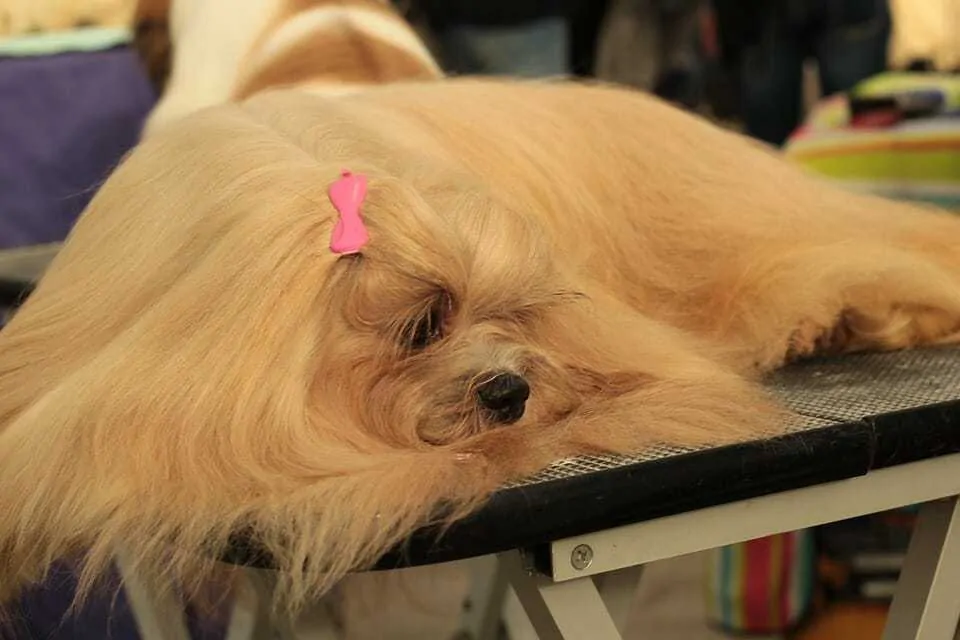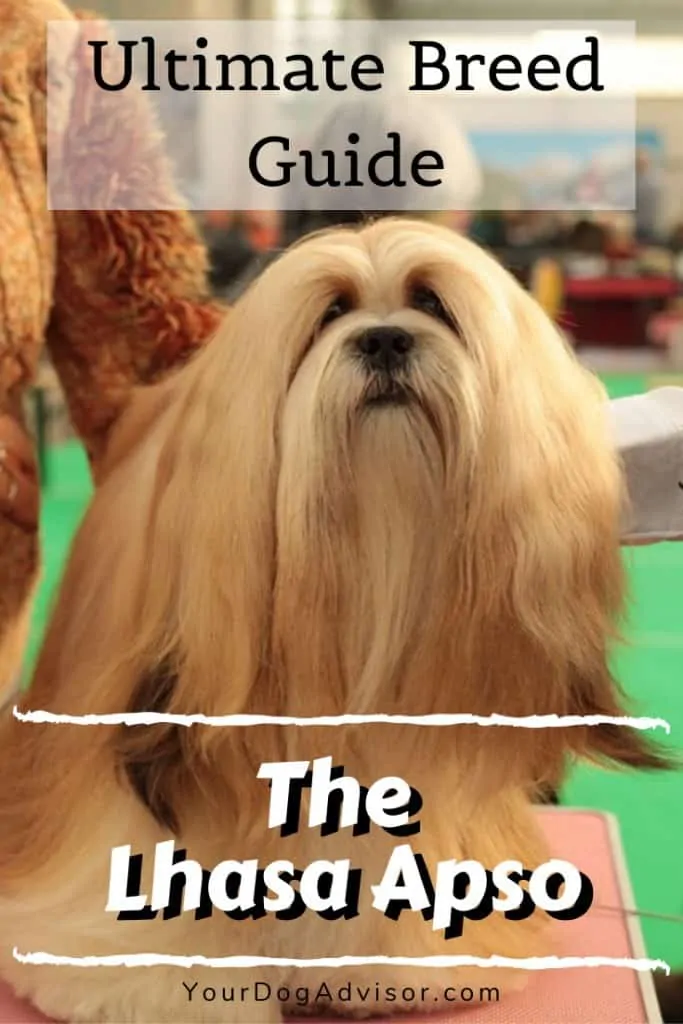Are you looking for a small dog with a big personality? This pint-sized guard dog from the Tibetan plateau may be worth considering. The Lhasa apso may look like a pampered toy pooch, but they exude the confidence and the swagger of a much larger canine.
Keep reading to find out if this unique “bearded dog” is right for you and your lifestyle.
Contents
General Characteristics of the Lhasa Apso
- Other names: Lhasa terrier, long-haired Lhasa dog
- Height: About 11 inches
- Weight: 12 to 18 pounds
- Lifespan: 12 to 15 years
- Origin: Tibet
- Colors: All colors are accepted but gold, cream, tan, and white with various markings are the most common.
- Activity level: Moderate
- Grooming needs: Moderate to heavy
- Best suited for: More active families with space considerations
Beyond being gorgeous, the Lhasa’s coat served an important purpose while used as a working dog in Tibet. The long, coarse outer hairs kept the dog dry while the wooly inner coat helped keep them warm during the long Tibetan winters.
The History of the Lhasa Apso
Like many of their Tibetan cousins, the Lhasa is one of the oldest dog breeds still around today. Records of the breed go back as far as 800 B.C. but it’s possible the breed is even older.
While the when may be a little hard to pinpoint, the why is well documented. The Buddhist monks of Tibet, and specifically those in the capital, Lhasa, used these small canines to guard monasteries. Large, intimidating Tibetan mastiffs were often kept outside the gates to ward off trespassers while the smaller apso was kept inside in order to catch any intruders who managed to slip through the doors.
The Lhasa is well adapted to this job. They have incredibly sensitive hearing as well as a keen sense of smell, which they would use to track movement and determine if a person was friend or foe. Their long, straight, and easily recognizable coat also served a purpose by keeping the small dogs warm even in the coldest and bleakest of Tibetan winters.
The long outer coat is coarse and heavy, with an appearance and texture much like human hair. It acts as a defense against moisture and cold. The inner coat is much softer and thinner and helps insulate the dog from sub-zero temperatures common even inside the temples.
These small dogs were used to guard Tibetan monasteries. They would prowl the halls listening and looking for trespassers. The Buddhists also regarded these dogs as good luck and gave them as gifts to those they respected.
Buddhists of the time believed that the apso was good luck and capable of harboring the spirit of a recently deceased Dalai Lama. For this reason, the dogs were never sold but were given away as gifts. One of the lucky recipients of gifted apsos was an explorer and naturalist named Suydam Cutting. He received a pair of them from the 13th Dalai Lama and brought them back to America in the 1930s.
But it wasn’t until the 14th Dalai Lama gifted out multiple dogs that the breed truly took off in the west.
Today, these dogs still retain much of their guarding instinct, but their main jobs include protecting the sofa from the cats, cuddling up with the family, and entertaining onlookers with their clownish personalities.
The Temperament of the Lhasa Apso
While their size makes them the perfect dog for apartment living, their keen sense of hearing and tendency to bark at any unusual noise can make them poor neighbors. But, if you are looking for a dog who will alert you of any suspicious activity around your home but don’t have the space for a rottweiler, an apso might be your best option.
Unlike many small breeds, these dogs can switch between aloof and hyper-attached depending on what you happen to be doing at the time. They are people pleasers in the sense that they will try to please you if what you want also please them.
When frustrated or angry, it isn’t uncommon for these dogs to lay down, roll over and stay put. But their stubbornness is all just part of the charm these unique dogs exhibit.
They tend to be more independent than many breeds their size and are good at entertaining themselves. Something that comes in handy for a dog that has a lot more energy than the typical small breed.
These dogs do best with owners who can provide a consistent schedule and consistent rules. They can be stubborn in general and are capable of becoming belligerently so if they feel they are being treated unfairly or too harshly by their owners. It isn’t uncommon for a frustrated apso to plop down to the ground and refuse to move.
Overall, these dogs are loving with their family, vigilant and standoffish with strangers, and intelligent but stubborn.
Health Issues Common to the Lhasa Apso Breed
Like many ancient breeds, the Lhasa is generally robust and healthy with only a few common hereditary issues plaguing the breed. Their eyes are especially prone to problems as are their kidneys, but many of these health concerns are becoming less common thanks to more responsible breeding.
Here are some of the health issues that can crop up in this breed:
- Progressive retinal atrophy
- Cherry eye
- Dry eye syndrome
- Blindness
- Sebaceous adenitis
- Hereditary kidney disfunction
While eye disorders in an apso should be taken seriously, there is some comfort in the fact that these dogs do very well even with full vision loss.
The key to a healthy apso is finding a reputable breeder and working with your vet to screen and treat eye issues and to check kidney functions. Frequent dental care and weight management is also a must.
Because they were bred to have such sensitive hearing and rely so heavily on that sense to interpret the world around them, many Lhasas don’t even miss a beat after going blind. They are able to easily compensate for their lack of sight by relying on their other senses.
In addition to eye problems, kidney dysfunction used to be quite common in the breed and was one of the main culprits in early deaths. Despite there being no test to determine if a dog carries this hereditary condition, a focus on removing dogs from the breeding pool who develop problems or have puppies who do, has significantly reduced the occurrence of the issue.
Still, to assure the best eye and kidney health, only consider purchasing one of these dogs from a respected and responsible breeder. A lot of small breeds like the apso are a mainstay at pet stores around the country. While many of these store owners claim their dogs come from reputable family breeders, the truth is no reputable breeder would sell dogs to a pet store. And you should expect any dog from this situation originated from a mass breeding operation or puppy mill.
If you would rather avoid the possibility of giving money to a puppy mill altogether, consider adoption instead. Even these royal lapdogs do find themselves homeless on occasion. Check with your local Lhasa apso rescue to see if they have any available dogs to fit your situation before looking into breeders.
Learn more about this ancient dog breed in this episode of Dogs 101.
Do Lhasa Apsos Do Well With Children and Other Pets?
Lhasas are not pushovers, which means they aren’t always the best choices for households with small children who like to push dogs around.
These dogs know what they like and what they don’t and they won’t hesitate to let you or your children know it. For that reason, they don’t usually do well with younger children or toddlers. They can get along well with older children and those that are gentle with dogs. Since they are liable to nip if they get unhappy, it’s best to supervise all interactions with children as well as houseguests.
When it comes to other dogs, Lhasa typically do well, assuming the other canine will respect their need to be top dog.
Despite their size, these dogs tend to be confident and dominant, even with dogs much larger than they are. Early socialization can help lessen the odds an apso will be aggressive toward other dogs, but the specific dynamic between two housemates is what will truly determine if there will be harmony or chaos.
Socialization with smaller pets and cats is also important during the puppy years if you want your dog to get along well with other furry family members. But, despite their original English name, the “Lhasa terrier,” these dogs don’t have a lot of prey drive and are a safer choice for multiple animal households than some other small, active breeds.
Plenty of socialization and lots of training early on in puppyhood is the key to ending up with a happy, sociable adult apso.
What to Consider Before Bringing Home a Lhasa Apso
Think this big dog in a tiny body is the right canine to bring into your home? Here are a few more things to consider.
Activity Level
While they do have a knack for entertaining themselves, these dogs will need some exercise from you if you want to keep them from becoming destructive. Luckily, they enjoy a lot of outdoor activities usually reserved for much larger dogs like hiking and extended walks. Because of their thick coat, they are especially good for winter activities like cross country skiing. Just expect to have to slow down a bit to accommodate those shorter legs.
In general, expect to have to spend at least 30 minutes a day taking your pup on a brisk walk to tire them out. Plus, a few more extended play sessions in the house.
Trainability
This breed’s independence and stubbornness often comes off as a lack of intelligence but that couldn’t be farther from the truth. In fact, they are smart enough to know when something doesn’t suit them and will usually quit before even giving it a try. They also can become exceedingly frustrated by repetition.
You have a variety of hairstyles to choose from when you own a Lhasa. The long, natural cut is preferred for show dogs, while variations with a cleaner face line and the puppy cut are most common for companion dogs.
To train a Lhasa, you will have to get creative. You must find a way to appeal to them. While tasty treats might be enough for some behaviors, they aren’t likely to work as well for others. These dogs aren’t a great choice for people who expect an obedient lapdog, but they can provide a fun challenge for owners who enjoy building a relationship based on mutual respect and understanding.
Grooming
You have two options when it comes to the apso coat, and neither is without some investment. You can keep that long, gorgeous hair that the breed is famous for, but you’ll need to commit to bathing it twice a month and brushing it frequently. Because the coat has to be dried quickly and fully to avoid mats, bathing is usually best saved for a professional with a standup dryer.
Your second option is to opt for the puppy cut and leave the coat short and manageable. While this style won’t take as much brushing, you will still need to take them to the groomer every couple months to have them shaved down.
Luckily, these dogs aren’t big shedders and tend to slough off hair a little at a time much like humans do. You will need to commit to frequent teeth brushing and nail trimming, however.
Nutrition
Years of living in the harsh climate of the high altitude Tibetan plateau has endowed these pups with the ability to use every last bit of the calories they ingest. In a modern-day home, that means these dogs are prone to weight gain and stomach upset with even just the littlest bit of extra food. Careful measuring and a high-quality diet is a must.
Because of their thick skin and elegant hair, they also require more protein and fat in their diet than the typical small breed. Expect to pay a premium for the right food, but take solace in the fact that they won’t need a ton of it at a time.
These little dogs grow to their adult size quickly, but it takes much longer for them to mature mentally, with some acting like puppies well into middle age.
Cost
Purebred puppies from a reputable breeder will cost you over $1,000. Certain lines, such as the Gompa line which is descended from dogs of the Drepung monastery, can run as much as $5,000 or more.
Beyond the upfront cost, they are fairly low cost to own. They don’t eat a lot and are relatively healthy. But you will need to budget for professional grooming equipment or multiple trips to the groomers each year.
>>>Find out how to save at the vet.
10 Fun Facts About the Lhasa Apso
Now that you know what it takes to own one of these elegant royal pups, here are a few more facts about the breed.
- Unlike most small dogs, Lhasa tend to mature very slowly.
- Traditionally, when Buddihsts gifted these dogs, they would do so in pairs as it was thought to bring good luck.
- This breed was originally part of the AKC terrier group, but was later moved into the non-sporting group.
- Like all Tibetan dogs, this dog is well suited for high-altitude environments and tolerates cold climates better than most small breeds.
- Because they are so attuned to their environment, these dogs are frequently credited with saving their families from dangers like house fires.
- These pups have a deceptively loud bark for their size.
- Their Tibetan name means “bark lion sentinel dog.”
Is that a dog or a rug? The Lhasa comes in a multitude of colors, including black, red, gold, liver, and white. So you can easily accessorize your pup to match the furnishings.
- It is not uncommon for this breed to live into their 20s.
- Because of their intelligence and sensitive hearing, they are often trained as hearing assistance dogs.
- Like all Tibetan dogs, the Lhasa tail is carried high over it’s back.
Before You Go
Wondering if there might be a better breed for you out there? Here are some more big dogs in small packages worth considering.

Sara Seitz has spent most of her life in the pet industry and has a bachelors in animal behavior from Colorado State University. Sara started working with dogs and cats as a high schooler at a rural boarding kennel. There she learned a lot about the bad and the ugly of the pet service industry. But not even the toughest day at that job would dissuade Sara from following her dream of working with animals.
In college, Sara got a job at a dog daycare and boarding facility in Fort Collins, Colorado. Her new career provided even more opportunities for learning about dog behavior than her classes did. As general manager of the daycare, Sara helped the company launch a new in-home pet sitting branch and trained to become a certified dog trainer. Between shifts taking care of peoples pets in-home and supervising dogs during playtime at the daycare, Sara organized and taught obedience classes.
Sara has always been passionate about bettering the lives of our canine companions. She soon found that advocating for and educating owners in the power of positive reinforcement training was one of the best ways to help dogs and their owners live happier lives.
